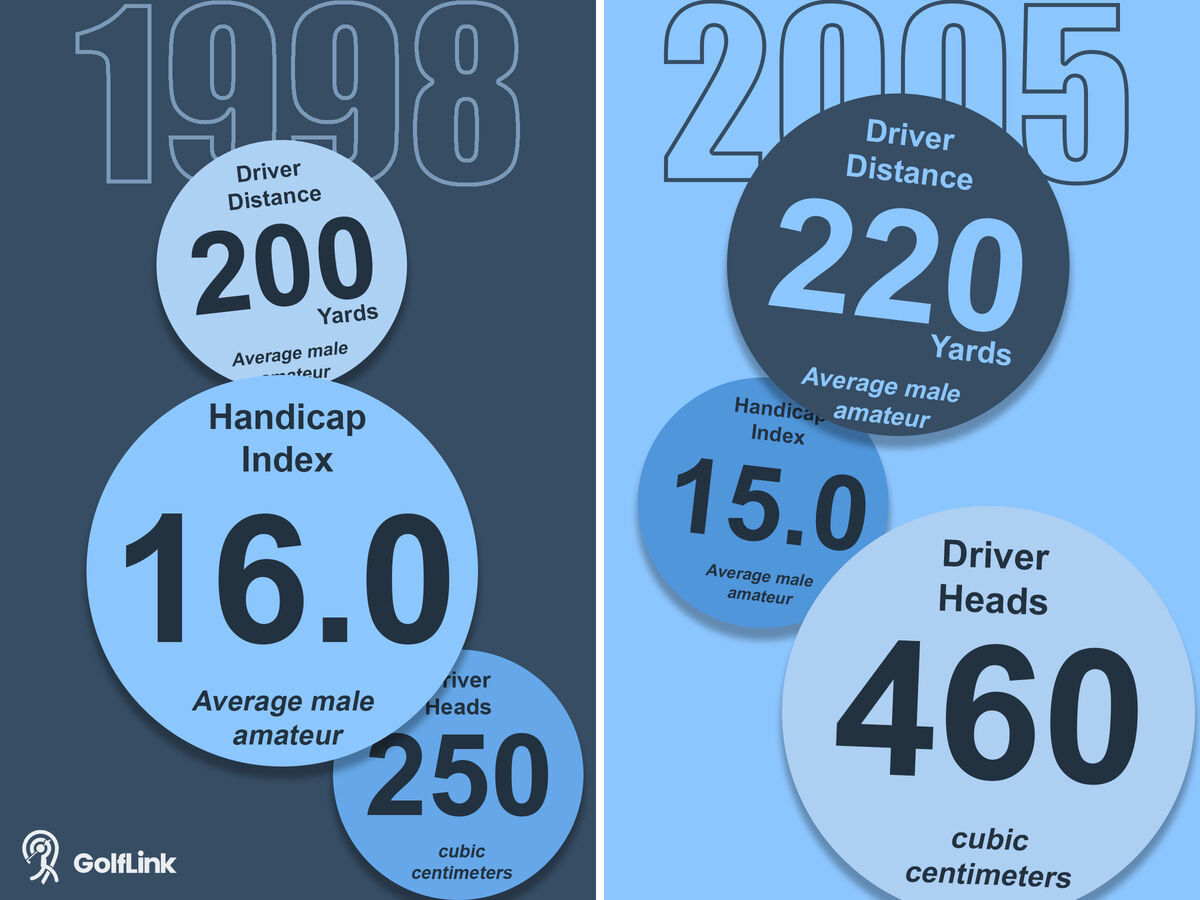The USGA's Biggest Win in the War on Distance

Chalk one up for the USGA. Two decades after golf’s governing body in the United States declared war on distance, it’s clear USGA made the right move, and perhaps saved golf as we know it.
Golf Equipment's Steroid Era
On October 29, 2003, the USGA notified manufacturers that beginning in 2004, clubhead volume would be limited to 460cc. That change halted a disturbing and unsustainable distance boom that benefitted even the world’s least-talented golfers.

The period from 1998-2005 is golf’s equivalent of baseball’s Steroid Era. The average male amateur golfer hit their driver 200 yards in 1998, when a driver with a 290 cubic centimeter head was considered huge. That average driver distance surged to 220 yards by the time the USGA released its first list of conforming driver heads in 2005.
If you don’t think a 20-yard improvement in seven years is absurd, consider the fact that once the changes took effect, amateur men’s driver distance dropped to 216 yards in 2006, and have only increased by one yard, up to 217, through 2019, the latest year for which the USGA collected data.
The Driver Boom
The Titleist 975D and Callaway Big Bertha drivers were among the most popular in the mid-to-late 90s, and each featured what was considered a massive clubhead at the time, at 260cc and 290cc, respectively.
Driver head sizes grew uncontrollably through the turn of the century with truly massive drivers like the 500cc Bullet B52 bomber, an anti-slice driver released in 2002 that was perfectly legal until the 2004 restriction took effect. Nearly every driver produced today is specced to the very USGA limit of 460cc.
The Impact of Bigger Drivers
It’s not rocket science. More distance means lower scores. But if you need further proof, here it is. When the average guy was hitting driver 200 yards, their average handicap index was 16.0, according to data provided to GolfLink by the USGA. By the time they hit it 220 yards, that handicap index dropped an entire stroke to 15.0.
Ladies had it even better, dropping two strokes from their average index in a similar timeframe, going from 29.9 to 27.9 between 1994-2004. There’s never been a period of more rapid improvement among amateur golfers in the USGA’s recorded average handicap index history, which dates back to 1991.
Since 2006, when men’s driver distance declined for the first time since the USGA stepped in, men have shaved less than half a stroke from their index, going from 14.8 to 14.4 in 2018, the final year the USGA has data under the former handicap formula.
Golf as We Know It
The truth is, the war on distance didn’t begin in 2004, and it didn’t end then either. The USGA has been governing golf equipment since 1909, when it insisted clubs shouldn’t “contain any mechanical contrivance, such as springs.” Still, as recently as 2016 the USGA and R&A are actively setting limits to golf clubs’ spring-like effect.
Nonetheless, the USGA’s move to limit clubhead size remains the most impactful move as far back as the data goes. Did the USGA’s changes save golf as we know it? Well, as a result, land-locked golf courses that are maxed out and simply don’t have room to grow remain relevant, and golf’s already glaring pace of play issues aren’t magnified by average golfers teeing it up on 7,500-yard or longer courses.
USGA Driver Distance & Handicap Index Data
| Year | Men's Driver Distance* | Avg. Men's Index |
Avg. Women's Index |
| 1991 | -- | 16.3 | 29.7 |
| 1994 | -- | 16.5 | 29.9 |
| 1995 | -- | 16.2 | 29.4 |
| 1996 | 206 | 16.3 | 29.4 |
| 1997 | 199 | 15.9 | 29.1 |
| 1998 | 200 | 16.0 | 28.9 |
| 1999 | 205 | -- | -- |
| 2000 | 214 | 15.7 | 28.5 |
| 2001 | 210 | 15.6 | 28.5 |
| 2002 | 212 | 15.5 | 28.2 |
| 2003 | 214 | 15.3 | 28.1 |
| 2004 | 211 | 15.2 | 27.9 |
| 2005 | 220 | 15.0 | 28.0 |
| 2006 | 216 | 14.8 | 27.7 |
| 2007 | 214 | 14.7 | 27.6 |
| 2008 | 210 | 14.6 | 27.4 |
| 2009 | 211 | 14.5 | 27.3 |
| 2010 | 212 | 14.5 | 26.9 |
| 2011 | 216 | 14.5 | 26.8 |
| 2012 | 209 | 14.3 | 26.5 |
| 2013 | 216 | 14.5 | 26.6 |
| 2014 | 211 | 14.6 | 26.7 |
| 2015 | 211 | 14.6 | 26.7 |
| 2016 | 212 | 14.4 | 26.1 |
| 2017 | 209 | -- | -- |
| 2018 | 217 | 14.4 | 26.2 |
| 2019 | 217 | -- | -- |
*Driver distance represents average yards among male amateurs as measured by the USGA.